2006 KIA Rio belt
[x] Cancel search: beltPage 37 of 220

Knowing your vehicle28
3
CAUTION -
Air bag/Pre-
tensioner dust
When the air bags and pre-tension-
ers are activated, a loud noise may
be heard and fine dust, which may
appear to be smoke, may be visible
in the passenger compartment. This
dust is not toxic. The dust may
cause skin irritation and should not
be breathed for prolonged periods.
Ventilate the vehicle after impact
and wash your hands and face thor-
oughly after an accident.
WARNING
- Air bag/pre-
tensioner warning light
If the SRS air bag warning light
does not illuminate when the igni-
tion key is turned to “ON” , or if it
remains illuminated after approxi-
mately 6 seconds, or if it illuminates
while the vehicle is being driven,
please have an authorized Kia deal-
er inspect the pre-tensioner and air
bag system as soon as possible.
WARNING
- Safety belt adjustment
To obtain maximum benefit from a
pre-tensioner seat belt:
The safety belt must be worn cor-
rectly.
The safety belt must be adjusted to the correct position.
WARNING
- Replacing
used pre-tensioners
Pre-tensioners are designed to
operate once. After activation,
pre-tensioner seat belts must be
replaced. All seat belts, of any
type, should always be replaced
after they have been worn during
a collision.
Do not attempt to replace the pre- tensioners yourself. This must be
done by an authorized Kia dealer.
CAUTION -
Hot parts
The pre-tensioner assembly mecha-
nism becomes hot during activa-
tion. Do not touch the pre-tensioner
seat belt assembly for several min-
utes after they have been activated.
WARNING
- Damaging the
pre-tensioners
Do not hit or strike the pre-ten-
sioner assemblies, especially
with a tool or heavy object.
Do not attempt to service or repair the pre-tensioners.
JB CAN 3.qxd 7/29/05 8:56 AM Page 28
Page 38 of 220
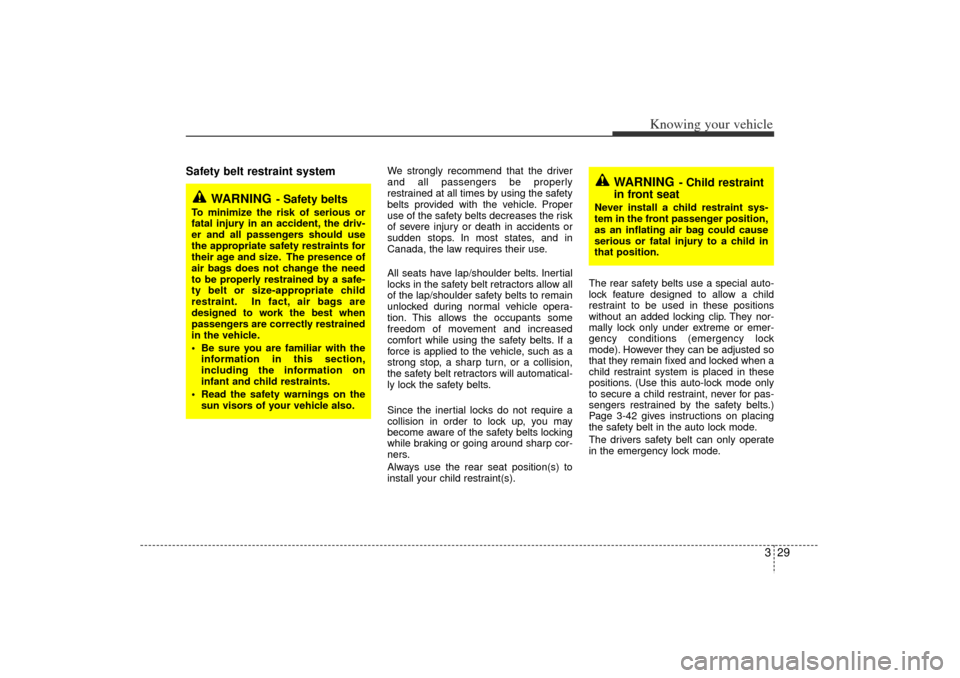
329
Knowing your vehicle
Safety belt restraint system
We strongly recommend that the driver
and all passengers be properly
restrained at all times by using the safety
belts provided with the vehicle. Proper
use of the safety belts decreases the risk
of severe injury or death in accidents or
sudden stops. In most states, and in
Canada, the law requires their use.
All seats have lap/shoulder belts. Inertial
locks in the safety belt retractors allow all
of the lap/shoulder safety belts to remain
unlocked during normal vehicle opera-
tion. This allows the occupants some
freedom of movement and increased
comfort while using the safety belts. If a
force is applied to the vehicle, such as a
strong stop, a sharp turn, or a collision,
the safety belt retractors will automatical-
ly lock the safety belts.
Since the inertial locks do not require a
collision in order to lock up, you may
become aware of the safety belts locking
while braking or going around sharp cor-
ners.
Always use the rear seat position(s) to
install your child restraint(s).The rear safety belts use a special auto-
lock feature designed to allow a child
restraint to be used in these positions
without an added locking clip. They nor-
mally lock only under extreme or emer-
gency conditions (emergency lock
mode). However they can be adjusted so
that they remain fixed and locked when a
child restraint system is placed in these
positions. (Use this auto-lock mode only
to secure a child restraint, never for pas-
sengers restrained by the safety belts.)
Page 3-42 gives instructions on placing
the safety belt in the auto lock mode.
The drivers safety belt can only operate
in the emergency lock mode.
WARNING
- Safety belts
To minimize the risk of serious or
fatal injury in an accident, the driv-
er and all passengers should use
the appropriate safety restraints for
their age and size. The presence of
air bags does not change the need
to be properly restrained by a safe-
ty belt or size-appropriate child
restraint. In fact, air bags are
designed to work the best when
passengers are correctly restrained
in the vehicle.
Be sure you are familiar with the
information in this section,
including the information on
infant and child restraints.
Read the safety warnings on the sun visors of your vehicle also.
WARNING
- Child restraint
in front seat
Never install a child restraint sys-
tem in the front passenger position,
as an inflating air bag could cause
serious or fatal injury to a child in
that position.
JB CAN 3.qxd 7/29/05 8:56 AM Page 29
Page 39 of 220

Knowing your vehicle30
3
(Continued)
Failure to heed these warnings and
follow these instructions will
increase the risk and severity of
injuries and the likelihood of death
in an accident.
Use the shoulder portion of the
safety belt on the outside shoul-
der only. Never wear the shoulder
portion under the arm.
Never swing the safety belt around your neck to fit over the
inside shoulder.
Never wear the shoulder portion of the safety belt across the neck
or face.
Wear the lap portion as low as possible. Be sure that the lap belt
fits snugly around the hips.
Never wear a lap portion of a
lap/shoulder belt over your waist;
it should always go over the
stronger area of your hips.
Never use a single safety belt for more than one person.
The front seatbacks should always remain in a comfortable,
upright position when the vehicle
is moving.
Safety belts provide the best restraint
when:
The seatback is upright.
The occupant is sitting upright (not
slouched).
The lap belt is snug across the hips.
The shoulder belt is snug across the chest.
The knees are straight forward.
WARNING
- After a collision
Lap/shoulder belt assemblies may be stretched or damaged
when subjected to the stress and
forces of a collision.
The entire restraint system should be inspected following
any collision. All belts, retractors,
anchors and hardware damaged
by a collision should be replaced
before the vehicle is operated
again.
WARNING -
Cargo area
(if equipped)
Passengers should never be
allowed to ride in the cargo area of
a vehicle. No safety belts are pro-
vided for the cargo area. Persons
riding in the vehicle without a fas-
tened safety belt are much more
likely to suffer serious bodily injury
or death during an accident.
WARNING
- Twisted belts
A twisted or jammed safety belt
cannot restrain you properly. If you
cannot untwist or unjam the safety
belt, have an authorized Kia dealer
service it immediately. Never drive
or ride with a twisted or jammed
safety belt.
WARNING
- Belt use
Safety belts must be used correctly
to work properly in an accident.
Each seating position in your vehi-
cle has a specific safety belt assem-
bly that includes a buckle and
tongue designed to be used togeth-
er. (Continued)
JB CAN 3.qxd 7/29/05 8:56 AM Page 30
Page 40 of 220

331
Knowing your vehicle
Safety belt warning light and
chimeAs a reminder to the driver and passen-
ger, safety belt warning light will blink for
approximately 6 seconds each time you
turn the ignition switch ON.
If the driver's lap/shoulder belt is not fas-
tened when the key is turned ON or if it is
disconnected after the key is turn ON,
the safety belt warning light will blink for
approximately 6 seconds.If the driver's lap/shoulder belt is not fas-
tened when the key is turned ON or if it is
disconnected after the key is turned ON,
the safety belt warning chime will sound
for approximately 6 seconds. (if equipped)
If the driver’s lap/shoulder belt is not fas-
tened within 30 seconds after the engine
is started, the safety belt warning light
and chime will activate for six seconds.
This cycle will repeat 11 times with an
interval of 24 seconds between cycles.
WARNING
- Safety belt
care
A damaged belt may not give you
the protection you need in an
accident.
Inspect your safety belts periodi- cally for excessive wear or dam-
age. Pull out each belt fully and
look for fraying, cuts, burns or
other damage. Pull the safety belt
out and let it retract a number of
times. Make sure that the
lap/shoulder belts return smooth-
ly and easily into the retractor.
Check the latches to make sure they latch and release without
interference or delay.
Never close the doors on any part of the lap or shoulder belt.
Any belt not in good condition or in good working order should be
promptly replaced.
CAUTION
Never close the doors on any part
of the lap or shoulder belt. It can
damage the safety belt or buckle
which could increase the risk of
injury in case of an accident.
1GQA2083
JB CAN 3.qxd 7/29/05 8:56 AM Page 31
Page 41 of 220
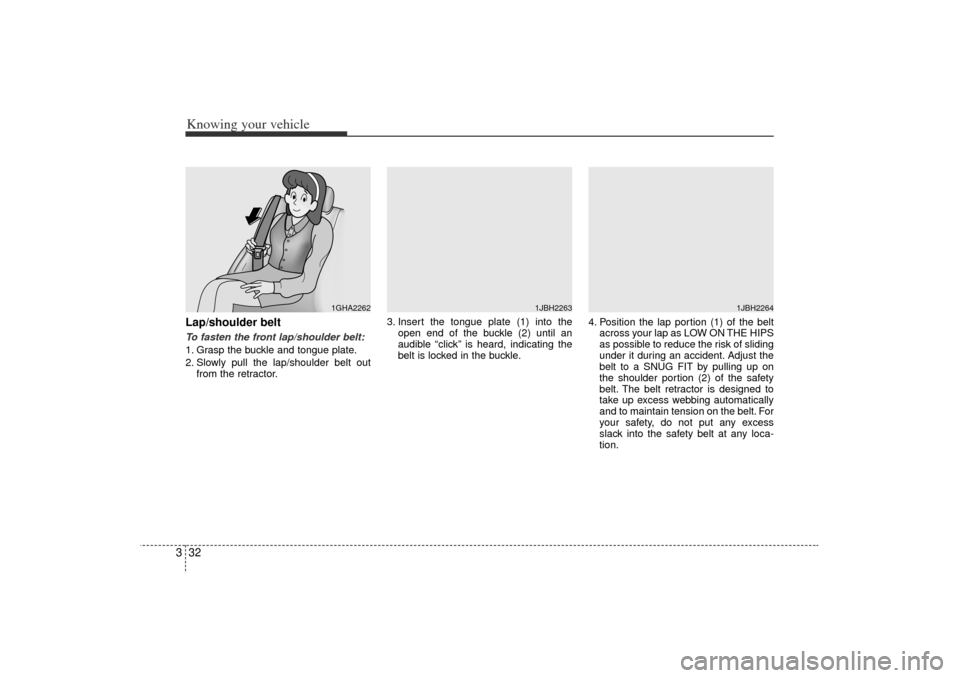
Knowing your vehicle32
3Lap/shoulder beltTo fasten the front lap/shoulder belt:
1. Grasp the buckle and tongue plate.
2. Slowly pull the lap/shoulder belt out
from the retractor. 3. Insert the tongue plate (1) into the
open end of the buckle (2) until an
audible “click” is heard, indicating the
belt is locked in the buckle. 4. Position the lap portion (1) of the belt
across your lap as LOW ON THE HIPS
as possible to reduce the risk of sliding
under it during an accident. Adjust the
belt to a SNUG FIT by pulling up on
the shoulder portion (2) of the safety
belt. The belt retractor is designed to
take up excess webbing automatically
and to maintain tension on the belt. For
your safety, do not put any excess
slack into the safety belt at any loca-
tion.
1JBH2263
1JBH2264
1GHA2262
JB CAN 3.qxd 7/29/05 8:56 AM Page 32
Page 42 of 220
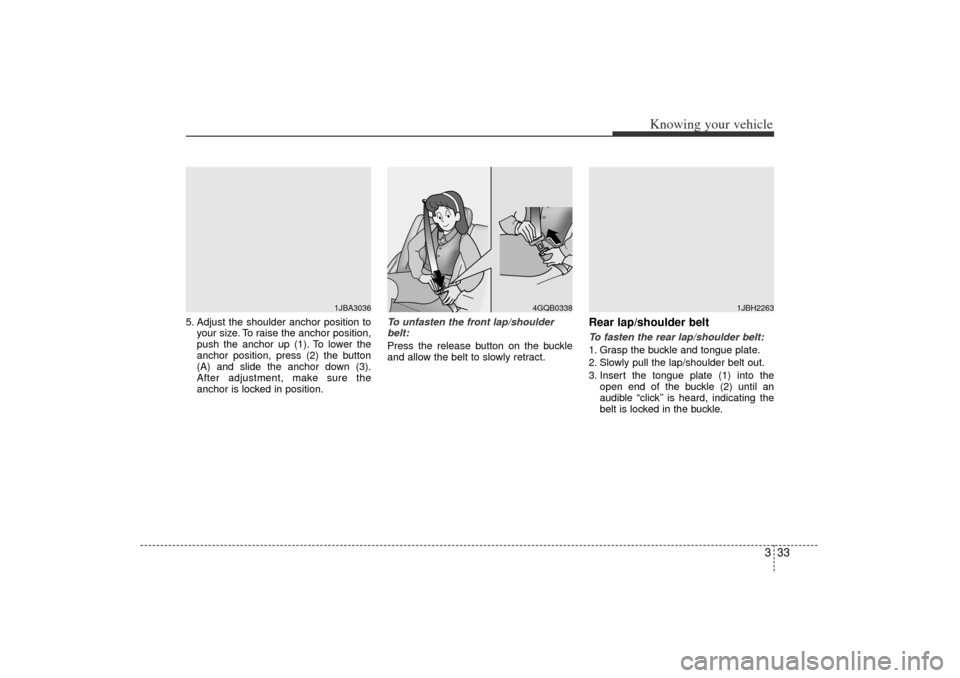
333
Knowing your vehicle
5. Adjust the shoulder anchor position toyour size. To raise the anchor position,
push the anchor up (1). To lower the
anchor position, press (2) the button
(A) and slide the anchor down (3).
After adjustment, make sure the
anchor is locked in position. To unfasten the front lap/shoulder
belt:
Press the release button on the buckle
and allow the belt to slowly retract.
Rear lap/shoulder belt To fasten the rear lap/shoulder belt:
1. Grasp the buckle and tongue plate.
2. Slowly pull the lap/shoulder belt out.
3. Insert the tongue plate (1) into the
open end of the buckle (2) until an
audible “click’’ is heard, indicating the
belt is locked in the buckle.
4GQB0338
1JBA3036
1JBH2263
JB CAN 3.qxd 7/29/05 8:56 AM Page 33
Page 43 of 220
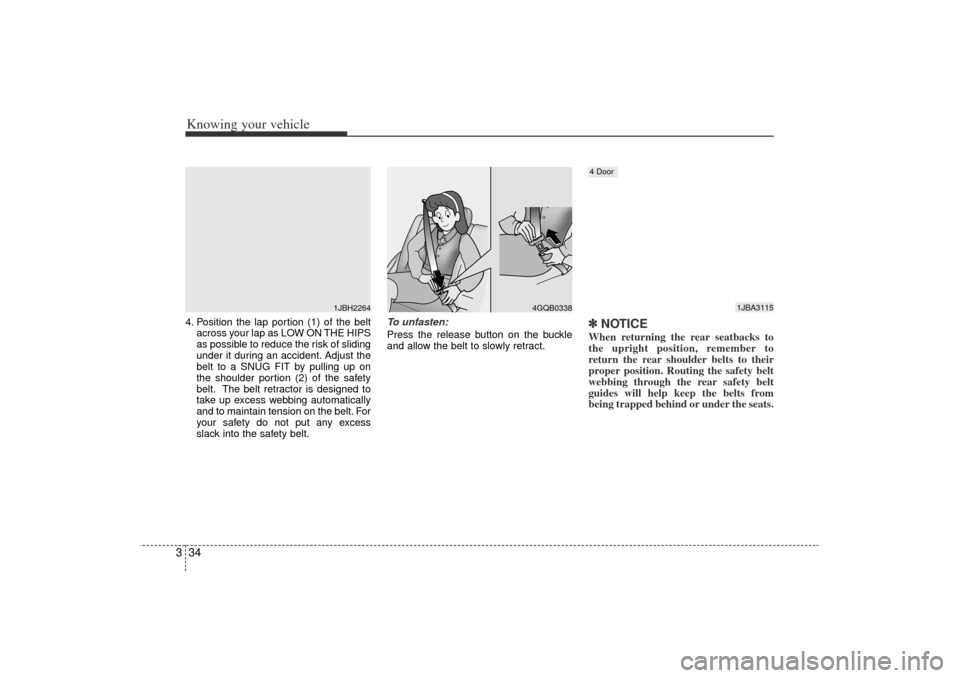
Knowing your vehicle34
34. Position the lap portion (1) of the belt
across your lap as LOW ON THE HIPS
as possible to reduce the risk of sliding
under it during an accident. Adjust the
belt to a SNUG FIT by pulling up on
the shoulder portion (2) of the safety
belt. The belt retractor is designed to
take up excess webbing automatically
and to maintain tension on the belt. For
your safety do not put any excess
slack into the safety belt. To unfasten:
Press the release button on the buckle
and allow the belt to slowly retract.
✽ ✽
NOTICEWhen returning the rear seatbacks to
the upright position, remember to
return the rear shoulder belts to their
proper position. Routing the safety belt
webbing through the rear safety belt
guides will help keep the belts from
being trapped behind or under the seats.
4GQB0338
1JBH2264
1JBA3115
4 Door
JB CAN 3.qxd 7/29/05 8:56 AM Page 34
Page 44 of 220
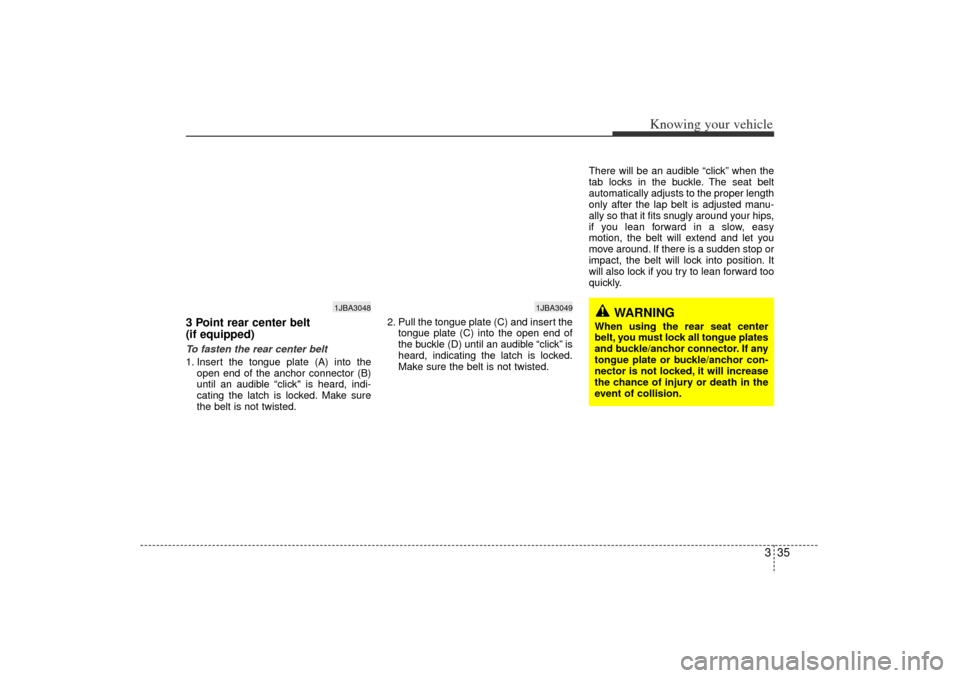
335
Knowing your vehicle
3 Point rear center belt
(if equipped) To fasten the rear center belt
1. Insert the tongue plate (A) into theopen end of the anchor connector (B)
until an audible “click" is heard, indi-
cating the latch is locked. Make sure
the belt is not twisted. 2. Pull the tongue plate (C) and insert the
tongue plate (C) into the open end of
the buckle (D) until an audible “click” is
heard, indicating the latch is locked.
Make sure the belt is not twisted. There will be an audible “click” when the
tab locks in the buckle. The seat belt
automatically adjusts to the proper length
only after the lap belt is adjusted manu-
ally so that it fits snugly around your hips,
if you lean forward in a slow, easy
motion, the belt will extend and let you
move around. If there is a sudden stop or
impact, the belt will lock into position. It
will also lock if you try to lean forward too
quickly.
1JBA3048
WARNING
When using the rear seat center
belt, you must lock all tongue plates
and buckle/anchor connector. If any
tongue plate or buckle/anchor con-
nector is not locked, it will increase
the chance of injury or death in the
event of collision.
1JBA3049
JB CAN 3.qxd 7/29/05 8:56 AM Page 35